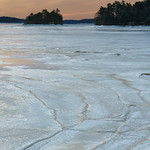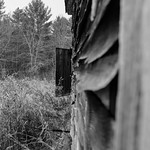- Home
- » About Maine
- » Invasive Species
Invasive Species
What is an invasive species?
An invasive species is a non-native species (including seeds, eggs, spores, or other propagules) whose introduction causes or is likely to cause economic harm, environmental harm, or harm to human health. The term "invasive" is used for the most aggressive non-native species. These species grow and reproduce rapidly, and can spread with or without human help, causing major disturbance to the areas where they are present. The estimated damage from invasive species worldwide totals more than $1.4 trillion, or five percent of the global economy. The estimated cost of invasive species damage to the U.S. is $120 billion annually (Pimental et al. 2005).
Invasive Aquatic Plants - Dept. of Environmental Protection
Invasive aquatic plants threaten the health of Maine's lakes and rivers.
Invasive aquatic species are introduced exotic flora and fauna that displace native plant and animal communities. Infestations result in habitat disruption, loss of property values, diminished water quality, reduced fishing and water recreation opportunities and significant expense for mitigating these environmental costs. Maine DEP's Invasive Aquatic Species Program addresses invasive aquatic species - primarily plants - in three ways: prevention, early detection and control.
Forest/Tree Pests - Dept. of Agriculture, Conservation and Forestry: Maine Forest Service
Monitoring trees and forests for signs of invasive species.
The Maine Forest Service surveys for invasive forest insects and diseases in a variety of ways. There are surveys for specific pests using traps and standardized visual monitoring as well as general forest pest surveys. Reports from the public are an invaluable method of detecting invasive species in a sparsely settled state. Detecting an invasive species early can allow for mitigation that will reduce the impact of the pest on Maine's forests.
Invasive Fish - Dept. of Inland Fisheries and Wildlife
“Introducing any new fish into Maine’s waters without proper authorization is illegal… and often forever.”
Illegal stockings of invasive fishes are a continuing problem in Maine waters. Each and every invasive introduction forever alters both the native fish assemblage and the ecosystem as a whole. Fisheries managers utilize a number of options to target and remove invasive fish populations including liberalized regulations, direct removal efforts, and chemical reclamation. Often the best defense isn't a regulation, a reclamation, or a removal. It is public education. Once illegal fishes are introduced into Maine waters, many times there is no turning back.
Marine Invaders - Dept. of Marine Resoruces
In the open marine environment there are many ways for invasive species to be introduced. From the ballast water of large ships to the hull of a family boat, when left untreated or uninspected can provide an easy ride for invasives.
We already have examples in Maine of the ecological and economic damage that can be done from an introduced species. The invasive green crab became established along the Maine coast many years ago. As their population expanded, they decimated clam flats, ecologically sensitive eel grass beds and churned the banks of our estuaries as they burrowed. With green crabs the opportunity for prevention has long past. Our best path forward is to find markets that encourage a commercial harvest and reduce crab numbers enough to mitigate their impact on our shore. With this example in mind the DMR is focused on prevention. We have programs in place to address issues like ballast water discharge and the importation and use of fish baits, but public awareness and prevention on a personal level will be key to preventing new invasions.
Plant Health Pests -Dept. of Agriculture, Conservation and Forestry: Cooperative Agricultural Pest Survey
The goal of the CAPS program is to provide an early warning system for pest detection and response that is critical for safeguarding our nation's agricultural and natural resources. Typical surveys target exotic and invasive pests and pests of export significance.

Asian Longhorned Beetle
Photo: Gale Ridge, CAES
Invasive Terrestrial Plants – Dept. of Agriculture, Conservation and Forestry: Horticulture Program
Industry Regulation
The Horticulture Program maintains a list of invasive terrestrial plant species that are prohibited from sale in Maine. The ban includes the listed species and all cultivars, varieties and hybrids. Variances may be applied and granted for scientific research and for varieties, cultivars or hybrids that are shown to not be invasive through scientific research. The invasive plant rule and prohibited plant list is reviewed every 5 years.
Invasive Terrestrial Plants – Dept. of Agriculture, Conservation and Forestry: Maine Natural Areas Program
Identification, Management & Reporting
Invasive terrestrial and wetland plants are a threat to Maine's beautiful natural areas, working farms and forests, and our backyards and open spaces. As part of their mission to conserve Maine's natural heritage, the Maine Natural Areas Program provides scientific guidance on identification, management, and monitoring of invasive terrestrial and wetland plants, and coordinates a statewide invasive species mapping tool, iMapInvasives.







